AMD Socket-AM2: Same Performance, Faster Memory, Lower Power
by Anand Lal Shimpi on May 23, 2006 12:14 PM EST- Posted in
- CPUs
A New FX
The next new CPU introduction that we're here to evaluate is the Athlon 64 FX-62, a 2.8GHz dual-core FX part that's debuting exclusively on the Socket-AM2 platform. Given AMD's policy of only having one active FX part at a time (prior violations of this rule aside), the FX-62 is the only FX on the AM2 platform. The FX-60 still reigns supreme on the Socket-939 platform, and since the two platforms perform the same we can pretty much compare the FX-60 to the FX-62 directly without worrying about any motherboard/memory/chipset differences skewing the comparison. Of course no very-high-end CPU comparison is complete without Intel's latest Extreme Edition processor, which in this case is the Pentium Extreme Edition 965 we reviewed back in March.
3D Rendering - Cinebench 9.5
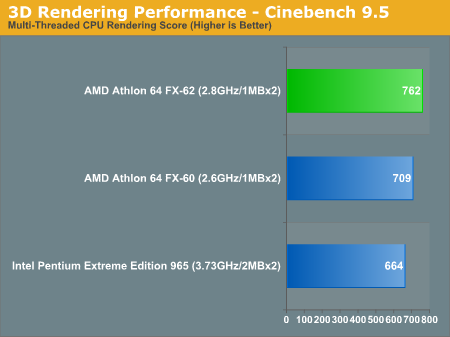
The beauty of the FX series of AMD processors is that its cache size doesn't vary like the rest of the Athlon 64 line, so the FX-62 has an undeniable performance advantage thanks to its 2.8GHz clock speed. The clock speed advantage is able to give it a pretty decent performance boost over the FX-60 here, as well as over the Pentium EE 965.
3D Rendering - 3dsmax 7
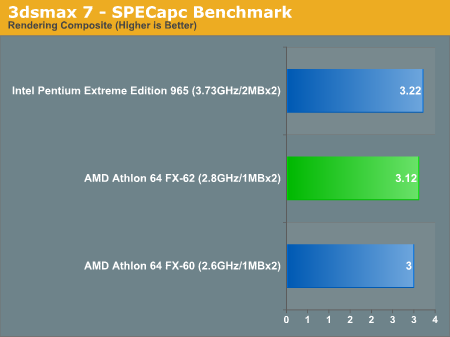
While we see a performance increase over the FX-60 in 3dsmax 7, it isn't enough to catch up to the performance of the Pentium EE 965. At 3.73GHz, the 965 is an extremely formidable competitor and very high performance CPU for 3dsmax rendering tasks.
Video Encoding - DivX 6.1.1 Pro
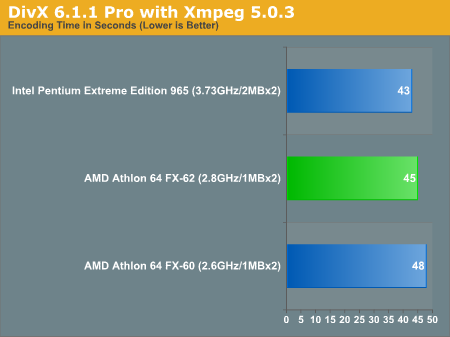
Intel gets the slight nod in DivX encoding performance, with the FX-62 falling smack in the middle of the chart here between the 965 and the FX-60.
Video Encoding - Windows Media Encoder 9
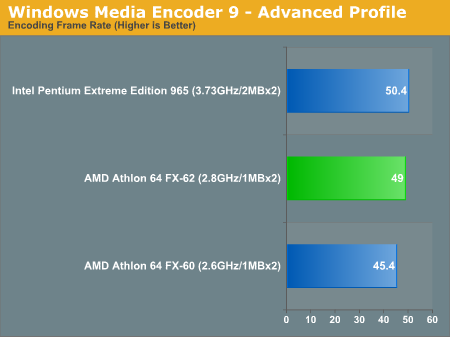
The situation doesn't really change with WME9; the FX-62 manages to come very close to the Extreme Edition 965's performance but falls a little short. The improvement over the FX-60 is quite noticeable here.
Video Encoding - Quicktime 7.0.4 (H.264)
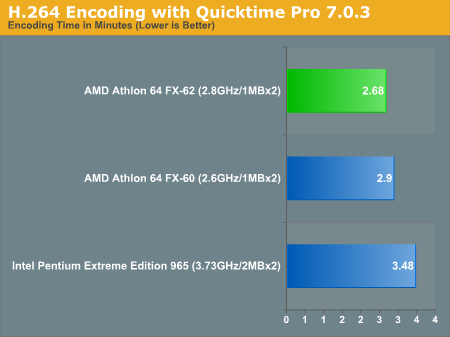
Apple's Quicktime for Windows has never run well on Intel processors, and the FX-62 takes good advantage of that fact by putting the Extreme Edition 965 to shame in our H.264 encoding test. After looking at the 4000+ vs. 3800+ comparison on the previous page, it's nice to see a real tangible performance difference between two AMD CPUs.
MP3 Encoding - iTunes 6.0.1.4
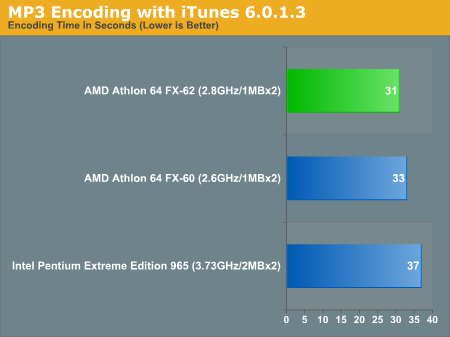
While all three CPUs are very competitive in their MP3 encoding performance the Athlon 64 FX-62 is the clear winner here, finishing the encoding task 16% faster than the Pentium EE 965.
Gaming - Quake 4
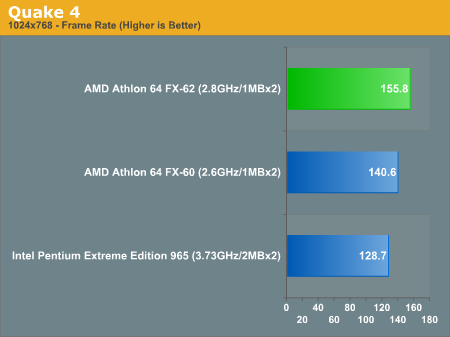
At higher clock speeds the Athlon 64 FX-62 really separates itself from the Pentium EE 965, offering a very significant 21% performance advantage in Quake 4.
Gaming - F.E.A.R.
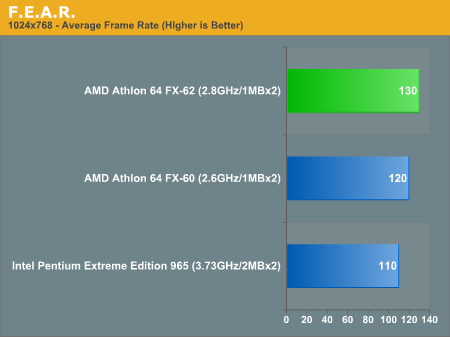
The AMD gaming advantage continues in F.E.A.R., this time the FX-62 holds on to a solid 18% lead.
Gaming - Oblivion
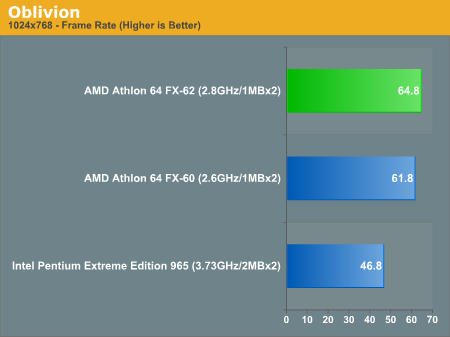
The Pentium Extreme Edition 965 is utterly disappointing in Oblivion, as the FX-62 outperforms it by an incredible 38%. With a very CPU and GPU dependent game like Oblivion, you can't ignore these types of performance differences, especially if you plan on feeding a pair of high end GPUs in SLI or CrossFire.
Athlon 64 FX-62 Conclusion
The Athlon 64 FX-62 verdict is a lot easier than with the 4000+ since the performance advantage is clear thanks to a 1MB L2 cache per core and an increase in clock speed. We would still recommend the FX-62 over the Extreme Edition 965 for gamers, but as we've seen in the past there are some situations where being able to execute four simultaneous threads, as you can with the EE, has its benefits.
Given the incredible price premium you pay for the FX-62, we would still strongly recommend going with a lower clocked Athlon 64 X2 instead. You can always overclock to get close to FX-62 performance or, alternatively, you could stay at the lower clock speed and enjoy lower thermal output.










83 Comments
View All Comments
Griswold - Tuesday, May 23, 2006 - link
Sounds conceiveable indeed. Though, the latter option would probably blow TDP out of proportion on 90nm.
mlittl3 - Tuesday, May 23, 2006 - link
Yeah, that is a problem but Anand did say "trick up its sleeve" so maybe they have one last 90 nm manufacturing process that's better than today's. I've read some articles about L3 cache coming for AMD and one inquirer.net article (take with grain of salt) that says AMD will ramp clock speeds fast. Maybe the trick will have something to do with these factors. Who knows?darkdemyze - Tuesday, May 23, 2006 - link
Whatever it is I'm interested in reading about itRegs - Tuesday, May 23, 2006 - link
Whatever it is, it's going to be expensive.TrogdorJW - Tuesday, May 23, 2006 - link
Actually, I was sort of thinking that the "stopgap solution" might be to cut prices. God only knows that I would love to see a $200 X2 processor!Griswold - Tuesday, May 23, 2006 - link
Well, they will have to drop prices at some point after core 2 is actually available.xFlankerx - Tuesday, May 23, 2006 - link
Indeed, same results as expected. Maybe this will make the AMD fanboys shut up about "waiting to see what the final results are." NOTE: I have a AMD system, I'm simply addressing those that refuse to accept Conroe's superiority.Although...I must say that this "stop gap" solution by AMD has piqued my curiosity.
But I believe that these say it perfectly;
"One of its stipulations for sending out Socket-AM2 review kits was that the CPUs not be compared to Conroe."
"We do get a sense of concern whenever Conroe is brought up around AMD."
"So when Intel first started talking about its new Core architecture, we turned to AMD for a response that it surely must have had in the works for years, but as you all know we came up empty handed."
Those just say it all for me. Seems like AMD's in trouble. From what I've been reading, K8L doesn't bring in architectural changes either. Sure you get Quad Cores, L3 cache, FB-DIMM support, DDR3, and faster HyperTransport, but if AMD doesn't improve on it's performance-per-clock efficiency, then Intel's Quad Cores (due almost 9 months before AMD's) are going to rule supreme yet again.
Griswold - Tuesday, May 23, 2006 - link
Maybe read up on it first.
Memory mirroring, data poisoning, HT retry protocol support, doubled prefetch size (32byte instead of 16), 2x 128bit SSE units (instead of 2x 64bit), out of order load execution, Indirect branch predictors and a handful new instructions sure sounds like a few architectural changes and not just a simple revision stepping.
rADo2 - Tuesday, May 23, 2006 - link
Sorry, links again:Intel Conroe @ 3.9GHz: SuperPI 1M - 12.984s
http://www.xtremesystems.org/forums/showthread.php...">http://www.xtremesystems.org/forums/showthread.php...
AMD FX-57 @ 4.2GHz: SuperPI 1M - 21.992s
http://www.xtremesystems.org/forums/showthread.php...">http://www.xtremesystems.org/forums/showthread.php...
MadAd - Monday, May 29, 2006 - link
Try measuring like for like and then come back with your silly benchmark comparison. EG use a superpi data size that will fit on BOTH cpus caches, not just conroes and then compare performance.With the FX57 having just a 1M cache its bullsht smoke and mirrors saying the 1M superpi is slower, o rly? perhaps thats because it takes more than 1M to hold both the feature and data sets on a 1M superpi.
muppet